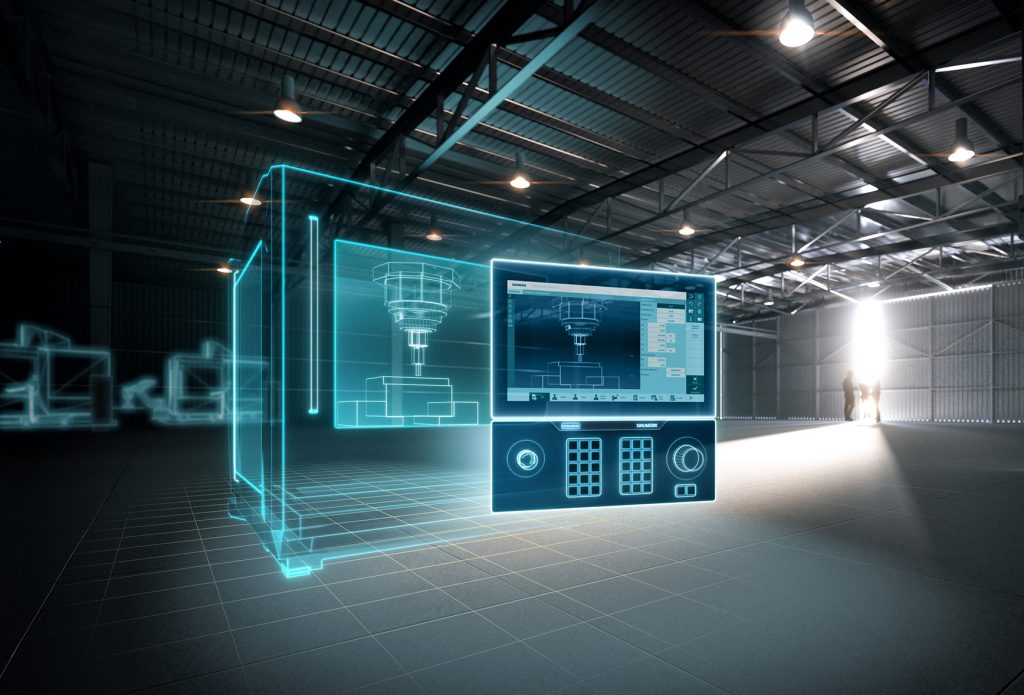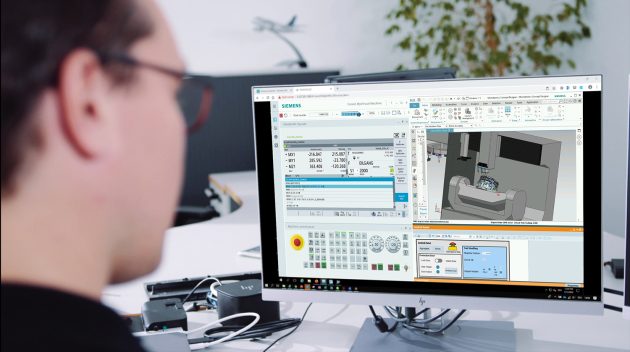
A telltale twin – accelerating development with a digital twin
November 8, 2021
By Karen Smock
Racer Machinery uses a digital twin to shorten the critical path for implementing complex machinery.
 Key CNC visual using Sinumerik One (PHOTO: Siemens)
Key CNC visual using Sinumerik One (PHOTO: Siemens) Alex Vojinovich, chief operating officer at Ontario-based automation and custom machinery builder Racer Machinery International was impressed by the results from using the digital twin of the new Sinumerik One controller from Siemens. “Even during the global pandemic, we saw an acceleration in our development and process time by up to 33 percent.”
A digital twin is a virtual representation of a product – in this case, a machine – that is used to simulate a process. Evolved well beyond mock-ups, these digital simulations have earned the label “twin.” The accuracy and reliability of a digital twin is making it an essential tool for designing, optimizing, troubleshooting and even providing machinery training.
For a project involving a complex piece of machinery, Racer engineers were working with Siemens to use the Sinumerik One digital-native CNC. Tiansu Jing, product manager at Siemens says, “For this project, Racer had a customer request for a solution to drive a multi-axis machine that used complex technology. When Racer came to us, we introduced the newly-released Sinumerik One controller, which covered all the requirements and performance needed for Racer’s customer’s machine. And, when we introduced the new Sinumerik One, we also introduced the native digital twin, which is unique in the market. At that time, neither Racer nor Racer’s customer were thinking about this kind of digital twin.”
Vojinovich explains, “We were not familiar with digital twin technology; however, we knew that we could trust in Siemens and its product’s quality. The fact that Sinumerik One allows us to have an acceleration in the development time of our machines and test them before being launched, encouraged us to use the digital twin.”
Having the digital twin available became extremely important once the pandemic restricted cross-border travel. Jing explains that normally they would do in-person training for a new piece of equipment. Since the Sinumerik One had a native digital twin, Siemens and Racer engineers each had a virtual machine on their computers. They were able to use online conferencing tools for training and troubleshooting.
No waiting necessary
Not only did the digital twin save time that would have been lost due to training delays, it also allowed the engineers to work on the solution without waiting out the two-to-three-month lead time to receive a physical controller. Jing explains, “Because they have the digital twin, Racer’s engineers did not need to wait for the real controller. They could start working on the digital twin to build the controller for that machine and start designing.”
In addition to normal lead time for the controller and other equipment, the pandemic caused delivery delays. However, since the engineers had the digital twin, they could continue to build the 3D model of the machine and configure the controller without waiting for delivery.
Vojinovich says, “With the virtualization feature, we can see how the machine will perform and make adjustments to our designs before proceeding through the building process, benefiting both the customer and the production process.”
Faster troubleshooting
When designing a new solution for complex machinery, challenges come up. Jing explains that normally, to help with troubleshooting, Siemens would send someone to the machine builder or have them send an archive of the machine that would allow Siemens engineers to replicate the issue on a test rack. To build the right test environment, the Siemens engineers have to make sure they have the same system software and setup and make the necessary PLC changes to create the same configuration as the customer. But, in this case, Racer engineers were able to simply send their digital twin project for the Siemens engineers to load and troubleshoot. The digital twin saved the time it would have taken to configure a physical test environment. Instead, the solution was found right away using the digital twin.

Creating a virtual machine (PHOTO: Siemens)
Training on virtual machines
The time-saving benefits of the digital twin aren’t limited to the design phase. Jing says, “If everything including training and testing is done on the real machine, then all these tasks are on the critical path of the overall project. But, with the digital twin, they can move the training to the virtual machine. With the 3D model Racer built, you can see the movement of each axis on the machine, and also see the material removed by the different tools. It can also simulate or detect if there is any potential collision.”
Jing explains the importance of taking the material removed into account, “At the beginning, the raw material is very big, but for example, after hours of cutting, the material is much smaller. So, when the machine is moving where there used to be raw material, there’s no collision alarm because the software knows that part is cut out.”
The training benefits include not only saved time, but saved raw materials and reducing the exposure of the actual machine to operator errors. With a digital twin, production doesn’t have to stop to allow a new operator to be trained.
Academic opportunities
Jing sees the digital twin as beneficial to vocational training programs as well as manufacturers. Schools that teach students how to design parts and operate machines, don’t have to be limited to the physical equipment in the labs. They can use digital twins to provide additional training. New students can make mistakes on the digital twin without damaging a physical machine or risking an accident. Using a digital twin will reduce raw material costs and wear on the tool. First cuts can be dangerous, but by having them verified virtually, problems can be identified and resolved with virtual simulations.
Jing explains how real the virtual machine can be for training purposes, “With the Sinumerik One digital twin, we offer software which is exactly the same as the real machine, as well as programming and a 3D model that’s the same as the real CNC controller. We can even add a real machine control panel so that instead of using a mouse, the operator does everything exactly the same way as they would do on a real machine.
Using the digital twin in academic settings also has Vojinovich’s support, “We are working with universities and colleges to develop and use academic platforms with Sinumerik One for operator training such as CNC machining, maintenance and repair.”
Vojinovich is impressed with the results. “With the digital twin, customers from education to manufacturing can learn, develop and experiment before they produce components on the machine. This brings us more integrated automation, the next level of Industry 4.0, the online and connectivity aspects and greater levels of productivity.”
The digital twin proved itself during the challenges brought on by the pandemic, but the benefits apply to normal business as well. Says Vojinovich, “Racer is always looking for advanced technology to address our customers’ needs and help them address the growing complexities and changes to manufacturing today. The digital twin helps not just to fulfill this goal, but also represents an improvement in our quality, productivity and performance.”
This article originally appeared in the October 2021 issue of Manufacturing AUTOMATION.
Advertisement
- Computing on the edge: Leveraging unlimited computing resources
- Avnu Alliance introduces advanced global TSN certification program; updates current testing procedures